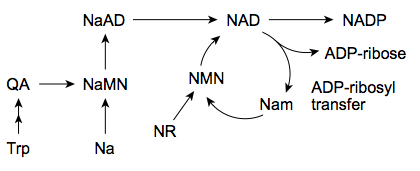This discussion was never really finished. I am taking Pterostilbene as it is supposed to be a more effective SIRT1 activator.
But it would appear the Resveratrol mechanism is different as could be read in this link that was posted earlier:
http://www.eurekaler...i-sun121914.php
"Tracking the resveratrol-bound TyrRS in the nucleus, the researchers determined that it grabs and activates the protein, PARP-1, a major stress response and DNA-repair factor thought to have a significance influence on lifespan. The scientists confirmed the interaction in mice injected with resveratrol. TyrRS's activation of PARP-1 led, in turn, to the activation of a host of protective genes including the tumor-suppressor gene p53 and the longevity genes FOXO3A and SIRT6"
Or could it be that actually Pterostilbene is not a SIRT1 activator but does the same as described above as it was supposed to work via same pathways as Resveratrol? And if that is the case then it would make sense to clarify the question Brian wrote down above.
I wrote that question and I've looked over the context of the surrounding posts from last year as a refresher. This was a time when I and others were still grappling with the NAD/PARP relationship and have since pinned it down. What I understand today is the PARP's are NAD consuming enzymes responsible for DNA maintenance among many other things. What we've read from studies on artificial PARP inhibition is they resulted in raising NAD levels which should be expected because these enzymes are major NAD consumers. The following excerpt is from a study that puts my earlier question to the test.
"To further solidify our data, we also wondered whether the enhanced NAD+ levels upon NR treatment could derive from alterations in the NAD+ salvage pathway or PARP activity. However, we could not see any change in Nampt mRNA or protein content in response to NR treatment (Fig.1G). Similarly, PARP activity and PARP-1 content were not affected by NR (Fig.1H). Altogether, these results suggest that NR increases NAD+ by direct NAD+ biosynthesis rather than by indirectly affecting the major NAD+ salvage (Nampt) or consumption (PARPs) pathways. Importantly, this increase in NAD+ was not linked to changes in cellular glycolytic rates or ATP levels (data not shown), which would be expected if NAD+/NADH ratios had been altered to the point of compromising basic cellular functions." http://www.ncbi.nlm....les/PMC3616313/
So increasing NAD levels with NR supplementation did not alter PARP activity. (no inhibition) So the backbone of those studies was to eventually see what would happen if every NAD consuming enzyme had its adequate amount to function. As might be expected "NR treatment enhances SIRT1 and SIRT3 activity" because all the NAD is not being depleted by PARP activity alone with the added NR supplementation.
Those PARP inhibition experiments showed us how much NAD was being consumed and what would happen if we limited PARP/NAD consumption. The result was increased oxidative metabolism and increased sirtuin activity. "Robbing Peter to Pay Paul," so to speak, but in an ideal world we would like all these enzymatic processes to have enough NAD to do their jobs uninhibited, hence NAD boosting via NR.
Now lets back away from the above and consider the results of just simply boosting our NAD. In doing so we get both SIRT1 and SIRT3 activation.
Returning to your last question and taking it one step further; if we are already boosting NAD, do we need Pterostilbene or Resveratrol? These are both similar molecules however Pterostilbene is claimed to be many times more bioactive. If we are stimulating the production of SIRT1 we have to consider that sirtuins are themselves NAD consumers. But these sirtuins will also help raise NAD background levels once stimulated, so eventually we should see some effect by taking them alone without NAD boosting. However they have not fully deciphered the pathways these molecules stimulate SIRT1. But evidence is suggesting Pterostilbene is more soluble than Resveratrol in reaching the blood plasma. To me its still a wait and see.
Hope that in part answers your question? We have discussed the NR, NAD, PARP relationship on subsequent posts since my question last year, obviously Pterostilbene or Resveratrol supplementation would factor into this but Pterostilbene or Resveratrol alone would not likely raise NAD levels as much as approaching it directly thru the NAD salvage cycle as we do with NR. I see both as adjuncts to NAD boosting "if they even work" and I do currently take Pterostilbene on the chance it does. Be aware there is controversy surrounding these molecules and a clear path of Sirtuin activation is still being studied. Both are reported to stimulate additional pathways besides SIRT1 activation either directly or as secondary effects so the research on both will be ongoing as these paths may be as or more important.
Their AMPK connection may be how they work. http://diabetes.diab...t/59/3/554.full
Here is a broad overview of Sirtuin-activating compounds (STACs), I personally do not support one side or the other and I'm waiting for more data to support the STAC notion.
http://biopharmconso...rtris-founders/
Edited by Bryan_S, 05 October 2015 - 07:45 PM.































 This topic is locked
This topic is locked























